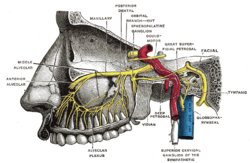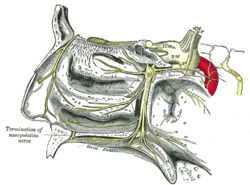Structure and Location of the Pterygopalatine Ganglion
- The pterygopalatine ganglion is located in the pterygopalatine fossa.
- It is triangular or heart-shaped and has a reddish-gray color.
- The ganglion is situated below the maxillary nerve as it crosses the fossa.
- It supplies the lacrimal gland, paranasal sinuses, nasal cavity and pharynx mucosa glands, gingiva, and the hard palate.
- It communicates anteriorly with the nasopalatine nerve.
Roots of the Pterygopalatine Ganglion
- The pterygopalatine ganglion has a sensory, parasympathetic, and sympathetic root.
- The sensory root is derived from two sphenopalatine branches of the maxillary nerve.
- The parasympathetic root is derived from the nervus intermedius through the greater petrosal nerve.
- The sympathetic root consists of fibers from the superior cervical ganglion.
Sensory Root of the Pterygopalatine Ganglion
- The sensory root of the pterygopalatine ganglion comes from the sphenopalatine branches of the maxillary nerve.
- Most of the fibers pass directly into the palatine nerves.
- Some fibers enter the ganglion, forming its sensory root.
Parasympathetic Root of the Pterygopalatine Ganglion
- The parasympathetic root of the pterygopalatine ganglion comes from the nervus intermedius through the greater petrosal nerve.
- In the ganglion, preganglionic parasympathetic fibers synapse with neurons.
- Postganglionic axons project to various areas, including the lacrimal glands and nasal mucosa.
Sympathetic Root of the Pterygopalatine Ganglion
- The pterygopalatine ganglion receives sympathetic efferent fibers from the superior cervical ganglion.
- These fibers travel through the carotid plexus and the deep petrosal nerve.
- The deep petrosal nerve joins with the greater petrosal nerve to form the nerve of the pterygoid canal.
- Fibers from the stellate ganglion pass through the superior cervical sympathetic ganglion and into the pterygopalatine ganglion.
This article includes a list of references, related reading, or external links, but its sources remain unclear because it lacks inline citations. (May 2015) |
The pterygopalatine ganglion (aka Meckel's ganglion, nasal ganglion, or sphenopalatine ganglion) is a parasympathetic ganglion in the pterygopalatine fossa. It is one of four parasympathetic ganglia of the head and neck, (the others being the submandibular, otic, and ciliary ganglion).
| Pterygopalatine ganglion | |
|---|---|
 Alveolar branches of superior maxillary nerve and pterygopalatine ganglion | |
 The pterygopalatine ganglion and its branches (pterygopalatine ganglion visible but not labeled, as large yellow ganglion in upper-right center) | |
| Details | |
| From | Maxillary nerve and nerve of pterygoid canal |
| To | Greater palatine nerve, lesser palatine nerve, posterior lateral nasal branches and nasopalatine nerve |
| Identifiers | |
| Latin | Ganglion pterygopalatinum |
| TA98 | A14.3.02.006 |
| TA2 | 6665 |
| FMA | 6965 |
| Anatomical terms of neuroanatomy | |
It is innervated by the Vidian nerve (formed by the greater superficial petrosal nerve branch of the facial nerve and deep petrosal nerve) and maxillary division of the trigeminal nerve. Its postsynaptic axons project to the lacrimal glands and nasal mucosa.
The flow of blood to the nasal mucosa, in particular the venous plexus of the conchae, is regulated by the pterygopalatine ganglion and heats or cools the air in the nose.
pterygopalatine ganglion (plural pterygopalatine ganglia)